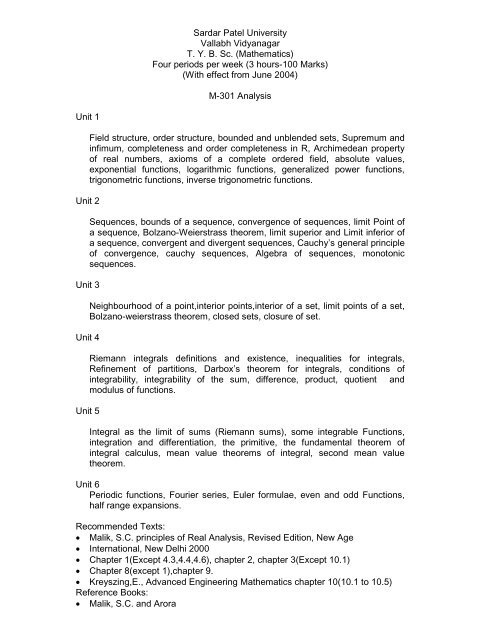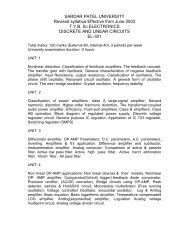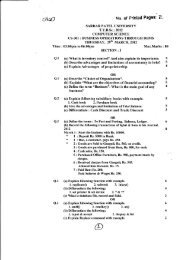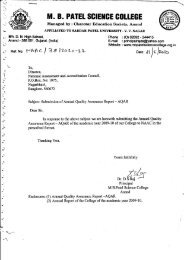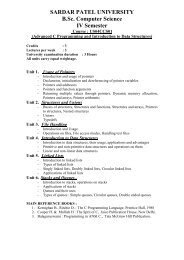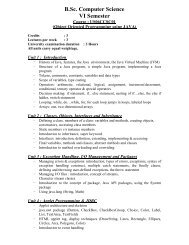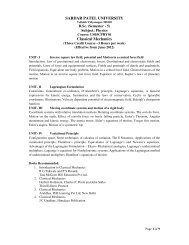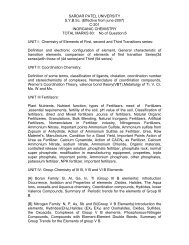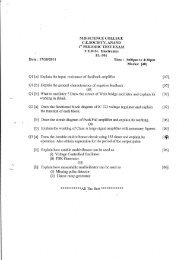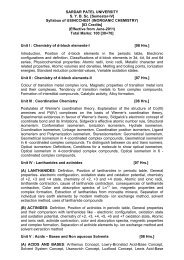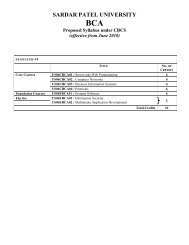Mathematics - MB Patel Science College
Mathematics - MB Patel Science College
Mathematics - MB Patel Science College
- No tags were found...
Create successful ePaper yourself
Turn your PDF publications into a flip-book with our unique Google optimized e-Paper software.
Sardar <strong>Patel</strong> UniversityVallabh VidyanagarT. Y. B. Sc. (<strong>Mathematics</strong>)Four periods per week (3 hours-100 Marks)(With effect from June 2004)M-301 AnalysisUnit 1Unit 2Unit 3Unit 4Unit 5Field structure, order structure, bounded and unblended sets, Supremum andinfimum, completeness and order completeness in R, Archimedean propertyof real numbers, axioms of a complete ordered field, absolute values,exponential functions, logarithmic functions, generalized power functions,trigonometric functions, inverse trigonometric functions.Sequences, bounds of a sequence, convergence of sequences, limit Point ofa sequence, Bolzano-Weierstrass theorem, limit superior and Limit inferior ofa sequence, convergent and divergent sequences, Cauchy’s general principleof convergence, cauchy sequences, Algebra of sequences, monotonicsequences.Neighbourhood of a point,interior points,interior of a set, limit points of a set,Bolzano-weierstrass theorem, closed sets, closure of set.Riemann integrals definitions and existence, inequalities for integrals,Refinement of partitions, Darbox’s theorem for integrals, conditions ofintegrability, integrability of the sum, difference, product, quotient andmodulus of functions.Integral as the limit of sums (Riemann sums), some integrable Functions,integration and differentiation, the primitive, the fundamental theorem ofintegral calculus, mean value theorems of integral, second mean valuetheorem.Unit 6Periodic functions, Fourier series, Euler formulae, even and odd Functions,half range expansions.Recommended Texts: Malik, S.C. principles of Real Analysis, Revised Edition, New Age International, New Delhi 2000 Chapter 1(Except 4.3,4.4,4.6), chapter 2, chapter 3(Except 10.1) Chapter 8(except 1),chapter 9. Kreyszing,E., Advanced Engineering <strong>Mathematics</strong> chapter 10(10.1 to 10.5)Reference Books: Malik, S.C. and Arora
Sardar <strong>Patel</strong> UniversityVallabh VidyanagarT.Y. B.Sc. (<strong>Mathematics</strong>)Four periods per week (3 hours-100 Marks)(With effect from June 2004)M-302: Graph TheoryUnit 1:Graph, applications of graph; finite and infinite graph; Incidence and Degree;isolated vertex; pendant vertex and null graph; isomorphism; Sub graphs;walks, paths and circuits; connected and disconnected Graphs; components;Euler graphs; operation on graph; more on Euler graphs; Hamiltonian pathsand circuits; the traveling salesman Problem.Unit 2:Trees and their properties, pendant vertices in a tree; distance and centers ina tree; rooted and binary trees; counting trees; spanning Trees; fundamentalcircuits; finding all spanning trees of a graph; Spanning trees in a weightedgraphsUnit 3:cut-sets and their properties; all cut-sets in a graph; fundamental circuits andcutsets; connectivity and separability; network flows; first and secondisomorphisms.Unit 4:Combinatorial Vs. Geometric graphs, planner graphs, kuratowski’s Twographs, different representations of a planar graphs, detection of Planarity,geometric and combinatorial duals; more on criteria of Planarity; thicknessand crossings.Unit 5:Modular arithmetic and Galois fields; vectors and vector spaces, Vectorspaces associated with a graph; basis vectors of a graph; Circuit and cut-setssubspaces; orthogonal vectors and spaces;Intersection and Join of W andW’s.Unit 6:Incidence matrix, sub matrices of A(G), circuits matrix, fundamental Circuitsand rank of B, An application to switching network, cut-set Matrix, relationshipamong reduced incidence matrix, fundamental Circuit Matrix andFundamental cut-set Matrix; path matrix.
Recommended Texts:Clark Narsingh, Graph theory with application to engineering andComputer science, Fourth printing, prentice Hall of India, 1987.Chapter 1 (1.1 to 1.5), chapter 2(except 2.3), chapter 3, chapter 4,chapter 5, chapter 6(except 6.1 and 6.2), chapter 7(except 7.9)Reference Books:Clark J. and Holton A.D., A first look at Graph Theory, First IndianReprint. Allied Publishers,1995.West, D.B., Introduction to graph theory, prentice Hall of India, NewDelhi, 1999.
Sardar <strong>Patel</strong> UniversityVallabh VidyanagarT.Y. B. Sc. (<strong>Mathematics</strong>)Four periods per week (3 hours-100 Marks)(With effect from June 2004)M-303: Topology of Metric spaces and ConvergenceUnit 1:Equivalence, countability, convergence and divergence, series withNonnegative terms, alternating series, conditional convergence andAbsolute convergence, rearrangements of series, tests for absoluteConvergence.Unit 2:Pointwise convergence of sequences of functions, uniforms convergence ofsequence of functions, consequences of uniform convergence.Unit 3:Convergence and uniform convergence of series of series of function,integration and differentiation of series of functions, Abel summability.Unit 4:Metric spaces, Limit in metric spaces, continuous functions on a Metricspace, open and closed sets.Unit 5:More about open sets, connected sets, bounded and totally boundedSets, complete metric spaces.Unit 6:Compact metric spaces, continuous functions on compact metric Spaces,continuity of the inverse function, uniform continuity.Recommended texts:Goldberg, R.R., Methods of Real Analysis, Oxford & IBH chapter 1(1.5 only), chapter 3(3.1 to 3.6) chapter 4(4.2,4.3), chapter 5(5.3,5.45.5),chapter 6,chapter 9(9.1 to 9.6)Reference Books :1. Malik, S.C. and Arora, savita, mathematical Analysis, second EditionNew Age International Pvt. Ltd., New Delhi 2000.
Sardar <strong>Patel</strong> UniversityVallabh VidyanagarT.Y. B.Sc. (<strong>Mathematics</strong>)Four periods per week (3 hours-100 Marks)(With effect from June 2004)M-304 Abstract AlgebraUnit 1:Equivalence relations and partitions; binary operations, Definition of Group,subgroups, cyclic groups, Langrange’s theorem.Unit 2:Isomorphisms, Homomorphism, Quotient groups, Direct products,Permutationgroups.Unit 3:Rings, Integrals domains, Isomorphism, Homomorphism, Quotient fields,Ideals, quotient rings, prime and maximal ideals.Unit 4:Factorization, Euclidean domain, principal ideal domain, Unique Factorizationdomain, Polynomial rings, roots of polynomials, factorization of polynomials.Unit 5:Unit 6:Vector spaces, subspaces, linear dependence, independence and bases.Linear transformations, matrices and linear transformations, Trace and Rankof a matrix and linear transformation.Recommended texts:Gopalakrishnan, N.S., University Algebra, second Edition, WileyEastern Ltd., New Delhi 1994.Chapter 1(Except 1.12,1.13 and 1.14), chapter 2, chapter 3(Except 3.6and 3.7), chapter 5(5.3,5.4(trace only),5.5)Reference Books:Herstein, I.N., Topics in algebra.Singal, Asha Rani, Algebraic structures,Whitesitt, J.Principles of mordern algebra.
Sardar <strong>Patel</strong> UniversityVallabh VidyanagarT.Y. B. Sc. (<strong>Mathematics</strong>)Four periods per week (3 hours-100 Marks)(With effect from June 2004)M-305 Number Theory and Complex AnalysisUnit 1:Divisibility, the division algorithm, g.c.d., Euclidean algorithm for Determiningthe g.c.d. of two integers, l.c.m. prime, prime and Composite numbers,fundamental theorem of arithmatics, Eclild’s Proof for infinitude of primes,general familiarity of Goldbach Conjecture and the twin prime problem.Unit 2:Congruences, congruence modulo m, algebric properties of congruences,complete and reduced residue system(mod m),Euler’s function (n), Fermat,Euler,Wilson’s theorems, solution of linear congruences, Chinese remaindertheorem.Unit 3:Special numbers, perfect numbers, Mersenne numbers, Fermat numbers,Fibonacci numbers, Numerical functions, greatest integer function, sumdivisorfunction, Mobius function (). Diophentine equations, linearDiophentine equation x2 + y2 =z2. The Diophentine equation x4 + y4 = z4(fermat’s last theorem n=4).Unit 4:Functions of complex variable limits, and their properties; involving the pointat infinity; continuity, derivatives, differentiation formula, Cauchy-Riemannequations.Unit 5:Sufficient conditions for analyticity, analytic and harmonic function;Theexponential function and its properties, trigonometric, hyperbolic andLogarithmic functions, branches of Logarithmic function.Unit 6:Inverse trigonometric and hyperbolic functions, Linear functions, the Function1/z, linear fractional transformations, mappings of the upper Half plane, thetransformations w=expz and w=sinz.
Recommended texts:Hsiung, C., Y., Elementary Theory of numbers, Allied publishers Ltd.(1992) chapter 1, chapter 2, chapter 3(only 3.1 and 3.2),chapter 4(only4.1), chapter 7(7.2(problem 3 and 4 only)).Churchill, R.V., Brown, J.W., Complex Variables and Applications,Fifth edition, McGraw-Hill Book Co.,1990.Articles9,11,12,13,14,15,16,17,18,19,20,21,22,23,24,25,26,29,64,65,66,67,68(exponent only),69.Reference Books:Burton D., elementary Number Theory, Universal Book stall, new DelhiNiven I. And Zuckermar H., An Introduction to the theory of Numbers,Wiley-Eastern Publication.Barnard S. and Child J.N., Higher Algebra, Mc Millan & Co. Ltd.Conway, J.B., Functions of one complex variables, Narosa publ. House,New Delhi,1973.
Sardar <strong>Patel</strong> UniversityVallabh VidyanagarT. Y. B. Sc. (<strong>Mathematics</strong>)Four periods per week (3 hours-100 Marks)(With effect from June 2004)M-306 MechanicsUnit 1:Ingredients of mechanics, position vector, velocity vector, acceleration vector,gradient vector, Fundamental laws of Newtonian mechanics, the theory ofdimensions. Plane statics, equilibrium of a particle, equilibrium of systems ofparticles, moment of force about a line, necessary and sufficient condition forequilibrium.Unit 2:Couples, work and potential energy, principle of virtual work, application, inplane statics, mass center and center of gravity, gravitational potential.Unit 3:Flexible cables, cable in cotact with smooth and rough curve, planeKinematics, kinematics of a particle, motion of a rigid body parallel to a plane.Unit 4:Methods of plane dynamics, motion of a particle, motion of a system of asystem of particles, applications in plane dynamics projectile with and withoutresistance.Unit 5:Motion under central force, planetary orbits, kinetic energy and angularmomentum of rigid body, moment of inertia of a rigid body.Unit 6:Rotational motion about a fixed line, impulsive motion, general theory ofplane, impulsive motion, collosion.Recommended texts:Synge, J.L and Griffith, B.A., principles of Mechanics, chapter 1, chapter 2(2.2,2.3,2.4), chapter 3(3.1 to 3.4) chapter 4(4.1,4.2), chapter 5(5.1,5.2),chapter 6(6.1 to 6.5), chapter 7(7.1,7.2),chapter 8(8.1,8.2).Reference Books:Chaterjee, P.N., Statics and Dynamics.
Sardar <strong>Patel</strong> UniversityVallabh VidyanagarT.Y. B. Sc. (<strong>Mathematics</strong>)Eight periods per week (6 hours-120 Marks)(With effect from June 2004)M-307 <strong>Mathematics</strong> Practicals 11. Recognition of the properties of functions from their graphs2. Constructions with a ruler and compass only3. Verification of geometric results4. Conics, string construction and verification of properties5. Construction of some curves and finding areas by various methods6. Symmetries in space and planes7. Network scheduling8. Mathematical Modelling of problems in natural and social sciences9. Objective questions10. Study of charts and mathematicians11. Solid surfaces and others models12. Making geometrical models13. Unbalanced transportation problems14. Game theory mixed strategy games15. Travelling salesman problem16. Job scheduling problems17. Graph theory
Sardar <strong>Patel</strong> UniversityVallabh VidyanagarT.Y. B. Sc. (<strong>Mathematics</strong>)Eight periods per week (6 hours-120 Marks)(With effect from June 2004)M-308 Mathematical Practicals 21. Basic Arimetic operations and expressions2. Finding greatest common divisor and last common multiple of integers,determination of-perfect numbers, prime numbers etc.3. Solution of polynomial equations and transcendental equations.4. Solution of simultaneous linear equations5. Basic operations on matrices; trace, transpose, determinant, rank ofmatrix.6. Upper triangularization, row echelon form and inverse of a matrix.7. Eigenvalues and eigenvectors of matrix.8. Basic operations on n-tuple of real numbers; dot product, norm, linearindependence.9. Interpolation10. Numerical integral and differentiation of a function.11. Solving a differential equation.12. Plotting curves (in Cartesian, polar and parametric equations)13. Bar Chart, Pie Chart14. Simplex method


